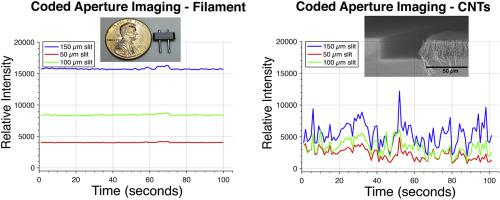当前位置:
X-MOL 学术
›
Int. J. Mass Spectrom.
›
论文详情
Our official English website, www.x-mol.net, welcomes your
feedback! (Note: you will need to create a separate account there.)
Comparison of thermionic filament and carbon nanotube field emitter-based electron ionization sources in cycloidal coded aperture mass analyzers
International Journal of Mass Spectrometry ( IF 1.6 ) Pub Date : 2020-11-01 , DOI: 10.1016/j.ijms.2020.116415 Raul Vyas , Philip J. Herr , Tanouir Aloui , Kathleen Horvath , Matthew P. Kirley , Charles B. Parker , Adam D. Keil , James B. Carlson , Justin Keogh , Roger P. Sperline , M. Bonner Denton , M. Luisa Sartorelli , Brian R. Stoner , Michael E. Gehm , Jeffrey T. Glass , Jason J. Amsden
International Journal of Mass Spectrometry ( IF 1.6 ) Pub Date : 2020-11-01 , DOI: 10.1016/j.ijms.2020.116415 Raul Vyas , Philip J. Herr , Tanouir Aloui , Kathleen Horvath , Matthew P. Kirley , Charles B. Parker , Adam D. Keil , James B. Carlson , Justin Keogh , Roger P. Sperline , M. Bonner Denton , M. Luisa Sartorelli , Brian R. Stoner , Michael E. Gehm , Jeffrey T. Glass , Jason J. Amsden

|
Abstract This work compares the coded aperture imaging performance of thermionic filament and carbon nanotube (CNT) field emitter-based electron sources in cycloidal-coded aperture mass spectrometers. The use of spatially coded apertures in mass spectrometry enables miniaturization by improving throughput without sacrificing resolution. CNT-based electron ionization sources for mass spectrometers provide several potential benefits over conventional thermionic emitters, including low voltage and low power consumption, room temperature operation, long lifetime, and ability to emit electrons in a pulsed mode. However, spatiotemporal variation in electron emission from CNTs is a major disadvantage. In this study, electron emission stability and spatiotemporal stability of the coded aperture image were compared for coded aperture cycloidal mass analyzers with either a CNT-based ion source or a thermionic filament-based ion source. We found that the thermionic filament-based ion source produced a significantly more stable coded aperture image than the CNT based ion source. The aperture image fluctuations in the CNT-based source are likely a result of adsorption and desorption of molecules on the CNT surface that cause local work function changes and induce spatiotemporal variation in electron emission and subsequent ion generation.
中文翻译:

摆线编码孔径质量分析器中基于热离子灯丝和碳纳米管场发射器的电子电离源的比较
摘要 这项工作比较了摆线编码孔径质谱仪中热离子灯丝和基于碳纳米管 (CNT) 场发射器的电子源的编码孔径成像性能。在质谱中使用空间编码孔径通过提高通量而不牺牲分辨率来实现小型化。用于质谱仪的基于 CNT 的电子电离源与传统热离子发射器相比具有多种潜在优势,包括低电压和低功耗、室温操作、长寿命以及以脉冲模式发射电子的能力。然而,碳纳米管电子发射的时空变化是一个主要缺点。在这项研究中,将编码孔径摆线质量分析器与基于碳纳米管的离子源或基于热离子灯丝的离子源的电子发射稳定性和编码孔径图像的时空稳定性进行比较。我们发现基于热离子灯丝的离子源比基于 CNT 的离子源产生了明显更稳定的编码孔径图像。基于 CNT 的源中的孔径图像波动可能是由于 CNT 表面分子的吸附和解吸导致局部功函数变化并引起电子发射和随后的离子生成的时空变化。
更新日期:2020-11-01
中文翻译:

摆线编码孔径质量分析器中基于热离子灯丝和碳纳米管场发射器的电子电离源的比较
摘要 这项工作比较了摆线编码孔径质谱仪中热离子灯丝和基于碳纳米管 (CNT) 场发射器的电子源的编码孔径成像性能。在质谱中使用空间编码孔径通过提高通量而不牺牲分辨率来实现小型化。用于质谱仪的基于 CNT 的电子电离源与传统热离子发射器相比具有多种潜在优势,包括低电压和低功耗、室温操作、长寿命以及以脉冲模式发射电子的能力。然而,碳纳米管电子发射的时空变化是一个主要缺点。在这项研究中,将编码孔径摆线质量分析器与基于碳纳米管的离子源或基于热离子灯丝的离子源的电子发射稳定性和编码孔径图像的时空稳定性进行比较。我们发现基于热离子灯丝的离子源比基于 CNT 的离子源产生了明显更稳定的编码孔径图像。基于 CNT 的源中的孔径图像波动可能是由于 CNT 表面分子的吸附和解吸导致局部功函数变化并引起电子发射和随后的离子生成的时空变化。











































 京公网安备 11010802027423号
京公网安备 11010802027423号